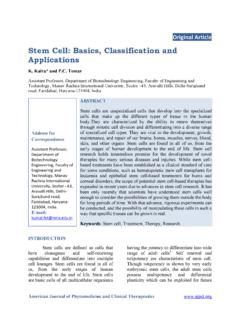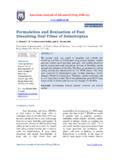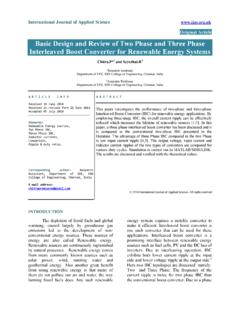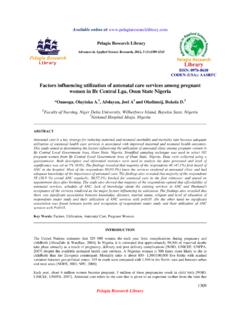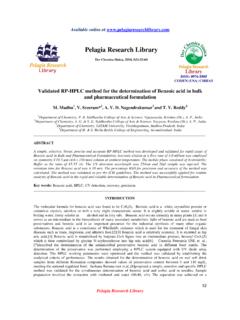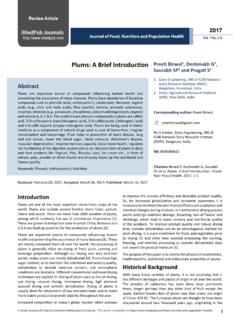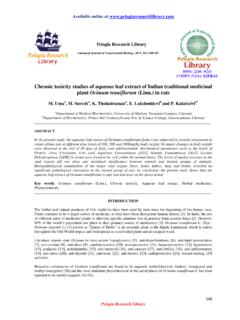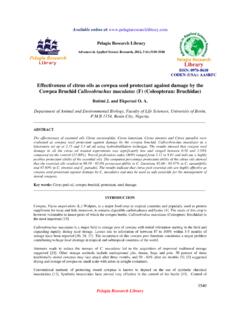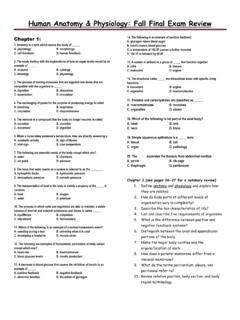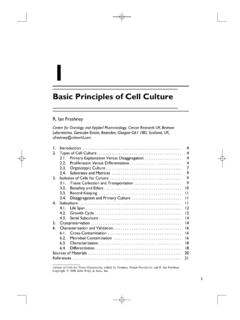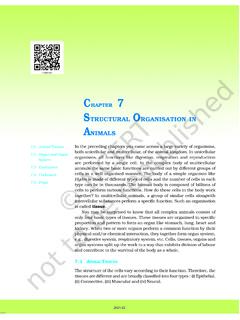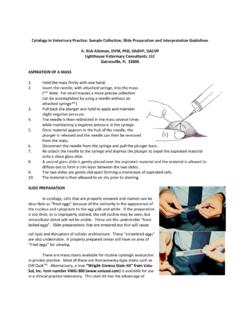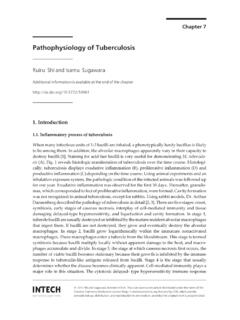Transcription of Stem Cell: Basics, Classification and Applications
1 Original Article Stem Cell: basics , Classification and Applications K. Kalra* and Tomar Assistant Professor, Department of Biotechnology Engineering, Faculty of Engineering and Technology, Manav Rachna International University, Sector 43, Aravalli Hills, Delhi-Surajkund road, Faridabad, Haryana-121004, India ABSTRACT. Stem cells are unspecialized cells that develop into the specialized cells that make up the different types of tissue in the human are characterized by the ability to renew themselves through mitotic cell division and differentiating into a diverse range Address for of specialized cell types. They are vital to the development, growth, Correspondence maintenance, and repair of our brains, bones, muscles, nerves, blood, skin, and other organs .Stem cells are found in all of us, from the Assistant Professor, early stages of human development to the end of life. Stem cell Department of research holds tremendous promise for the development of novel Biotechnology therapies for many serious diseases and injuries.
2 While stem cell- Engineering, Faculty of based treatments have been established as a clinical standard of care Engineering and for some conditions, such as hematopoietic stem cell transplants for Technology, Manav leukemia and epithelial stem cell-based treatments for burns and Rachna International corneal disorders, the scope of potential stem cell-based therapies has University, Sector 43, expanded in recent years due to advances in stem cell research. It has Aravalli Hills, Delhi- been only recently that scientists have understood stem cells well Surajkund road, enough to consider the possibilities of growing them outside the body Faridabad, Haryana- for long periods of time. With that advance, rigorous experiments can 121004, India. be conducted, and the possibility of manipulating these cells in such a E-mail: way that specific tissues can be grown is real. Keywords: Stem cell, Treatment, Therapy, Research. INTRODUCTION.
3 Stem cells are defined as cells that having the potency to differentiate into wide have clonogenic and self-renewing range of adult cells1. Self renewal and capabilities and differentiate into multiple totipotency are characteristic of stem cell. cell lineages. Stem cells are found in all of Though totipotency is shown by very early us, from the early stages of human embryonic stem cells , the adult stem cells development to the end of life. Stem cells possess multipotency and differential are basic cells of all multicellular organisms plasticity which can be exploited for future American Journal of Phytomedicine and Clinical Therapeutics Kalra et al_____ ISSN 2321 2748. generation of therapeutic options2. All stem 1800's with the discovery that some cells cells may prove useful for medical research, could generate other cells . In the early but each of the different types has both 1900's the first real stem cells were promise and limitations3.
4 Discovered when it was found that some For decades, researchers have been cells generate blood cells . The term "stem studying the biology of stem cells to figure cell" was proposed for scientific use by the out how development works and to find new Russian histologist Alexander Maksimov in ways of treating health problems4. The 1908. Bone marrow transplant between two scientific researchers and medical doctors of siblings successfully treated SCID in 1968. today hope to make the legendary concept of Haemopoietic stem cells were discovered in regeneration into reality by developing human cord blood in 19788. therapies to restore lost, damaged, or aging James Thomson and coworkers cells and tissues in the human body5. This derived the first human embryonic stem cell research has opened new horizons for stem line at the University of Wisconsin Madison cell research. in 19988. More recently, in 2005, scientists Stem cell research holds tremendous at Kingston University in England were promise for the development of novel purported to have found another category of therapies for many serious diseases and stem cells .
5 These were named cord blood injuries. While stem cell-based treatments embryonic-like stem cells , which originate have been established as a clinical standard in umbilical cord blood. Korean researcher of care for some conditions, such as Hwang Woo-Suk (2004 2005) claimed to hematopoietic stem cell transplants for have created several human embryonic stem leukemia and epithelial stem cell-based cell lines from unfertilised human oocytes9. treatments for burns and corneal disorders, Scientists at Newcastle University in the scope of potential stem cell-based England create the first ever artificial liver therapies has expanded in recent years due cells using umbilical cord blood stem cells to advances in stem cell research6. It is in October 200610,11. It is suggested that impossible to project when actual treatments these stem cells have the ability to or cures might emerge from such research, differentiate into more cell types than adult but the paths this research might take and stem cells , opening up greater possibilities potential Applications have been much for cell-based therapies.
6 Then, in early 2007, discussed7. Stem cells can now be grown researchers led by Dr. Anthony Atala and transformed into specialized cells with claimed that a new type of stem cell had characteristics consistent with cells of been isolated in amniotic fluid12. This various tissues such as muscles or nerves finding is particularly important because through cell culture. Highly plastic adult these stem cells could prove to be a viable stem cells from a variety of sources, alternative to the controversial use of including umbilical cord blood and bone embryonic stem cells13. Mario Capecchi, marrow, are routinely used in medical Martin Evans, and Oliver Smithies won the therapies. This review focuses on types of 2007 Nobel Prize for Physiology or stem cells , their sources, stem cell research Medicine for their work on embryonic stem and future aspects7. cells from mice using gene targeting strategies producing genetically engineered Historical perspectives mice (known as knockout mice) for gene The history of stem cell research had research14.
7 A benign, embryonic beginning in the mid AJPCT[2][7][2014]919-930. Kalra et al_____ ISSN 2321 2748. The first published study of bones, muscles, nerves, blood, skin, and successful cartilage regeneration in the other organs3. human knee using autologous adult Laboratory studies of stem cells mesenchymal stem cells is published by enable scientists to learn about the cells '. clinicians from Regenerative Sciences in essential properties and what makes them 200815. Embryonic stem cell isolated from a different from specialized cell types. single human hair was reported in 200816. Scientists are already using stem cells in the Australian scientists (2009) found a way to laboratory to screen new drugs and to improve chemotherapy of mouse muscle develop model systems to study normal stem cells17. Kim et al. 200918. Announced growth and identify the causes of birth that they had devised a way to manipulate defects20. Research on stem cells continues skin cells to create patient specific "induced to advance knowledge about how an pluripotent stem cells " (iPS), claiming it to organism develops from a single cell and be the 'ultimate stem cell solution'.
8 For the how healthy cells replace damaged cells in first time, human embryonic stem cells have adult organisms. Stem cell research is one of been cultured under chemically controlled the most fascinating areas of contemporary conditions without the use of animal biology, but, as with many expanding fields substances, which is essential for future of scientific inquiry, research on stem cells clinical uses in 201019. raises scientific questions as rapidly as it Over the last few years, national generates new discoveries21. Over the past policies and debate amongst the public as year, adult stem cells have been used either well as religious groups, government exclusively or in combination with other officials and scientists have led to various treatments to achieve significant "healthcare laws and procedures regarding stem cell benefits" for sufferers of the every tissue of harvesting, development and treatment for human body ( )22,23.
9 Research or disease purposes. The goals of such policies are to safeguard the public Classification of stem cells on the basis of from unethical stem cell research and use potency while still supporting new advancements in Stem cells can be classified by the the field. extent to which they can differentiate into different cell types. These four main Stem cell classifications are totipotent, pluripotent, A stem cell is a non-specialized, multipotent, or unipotent. generic cell which can make exact copies of itself indefinitely and can differentiate and Totipotent produce specialized cells for the various The ability to differentiate into all tissues of the body2 .Stem cells are cells possible cell types (Fig-3). Examples are the found in most, if not all, multi-cellular zygote formed at egg fertilization and the organisms. They are characterized by self- first few cells that result from the division of renewal and potency - the ability to the zygote.
10 Renew themselves through mitotic cell division and differentiating into a diverse Pluripotent range of specialized cell types2 (Fig. 1). The ability to differentiate into They are vital to the development, growth, almost all cell types. Examples include maintenance, and repair of our brains, embryonic stem cells and cells that are derived from the mesoderm, endoderm, and AJPCT[2][7][2014]919-930. Kalra et al_____ ISSN 2321 2748. ectoderm germ layers that are formed in the Adult stem cells beginning stages of embryonic stem cell Adult stem cells are undifferentiated differentiation. totipotent or multipotent cells , found throughout the body after embryonic Multipotent development, that multiply by cell division The ability to differentiate into a to replenish dying cells and regenerate closely related family of cells . Examples damaged tissues. ( ). The primary roles include hematopoietic (adult) stem cells that of adult stem cells in a living organism are can become red and white blood cells or to maintain and repair the tissue in which platelets.

